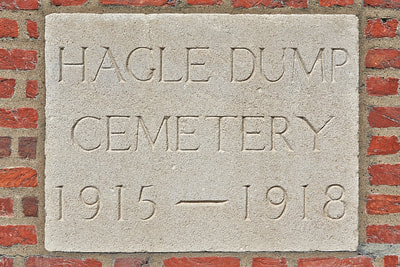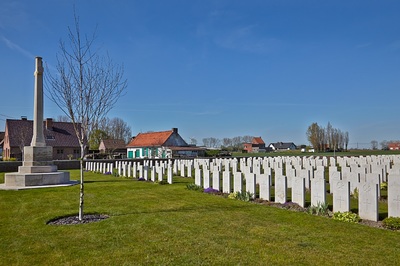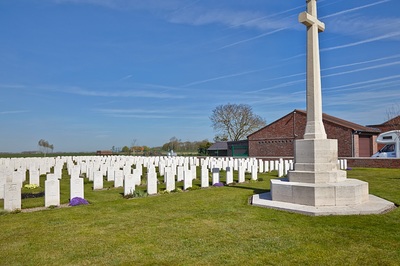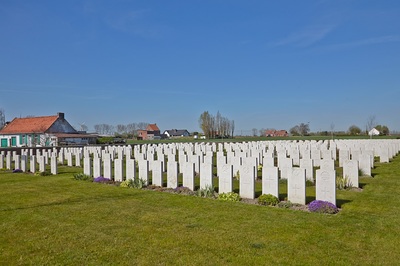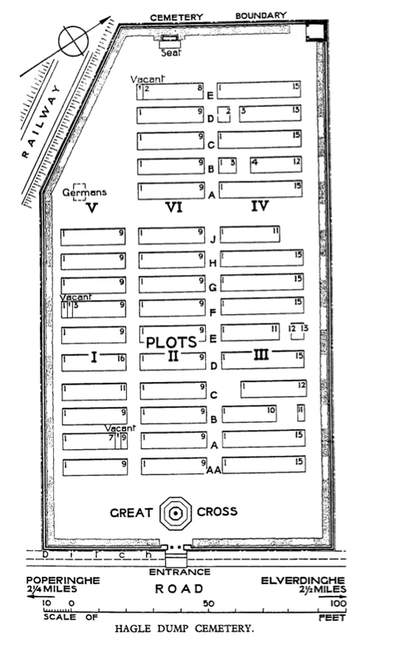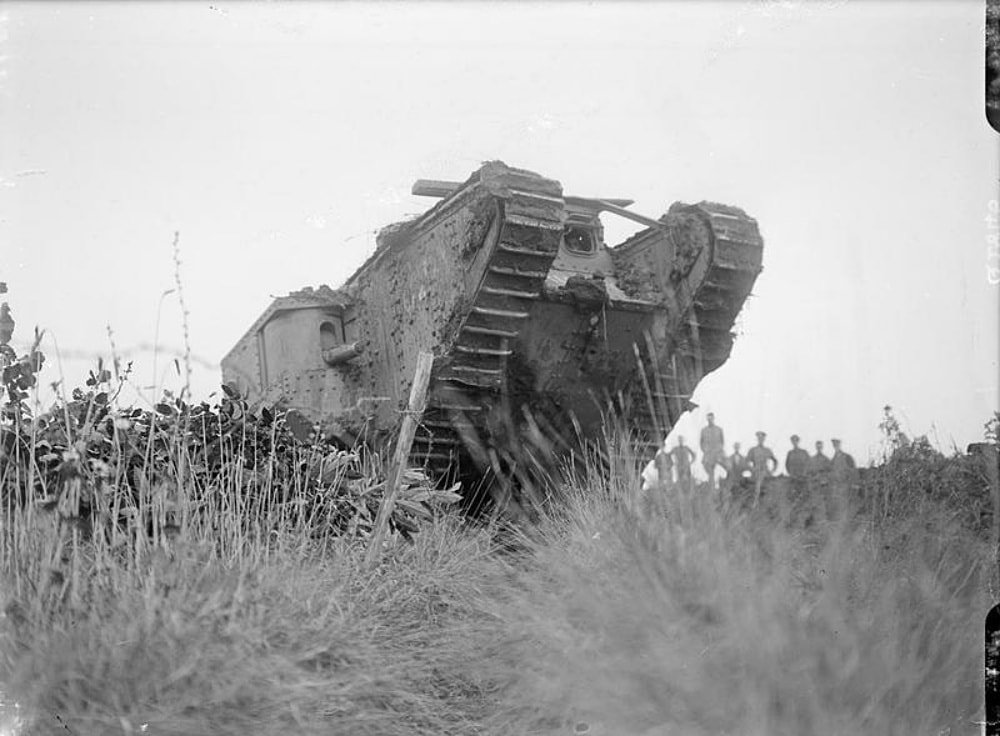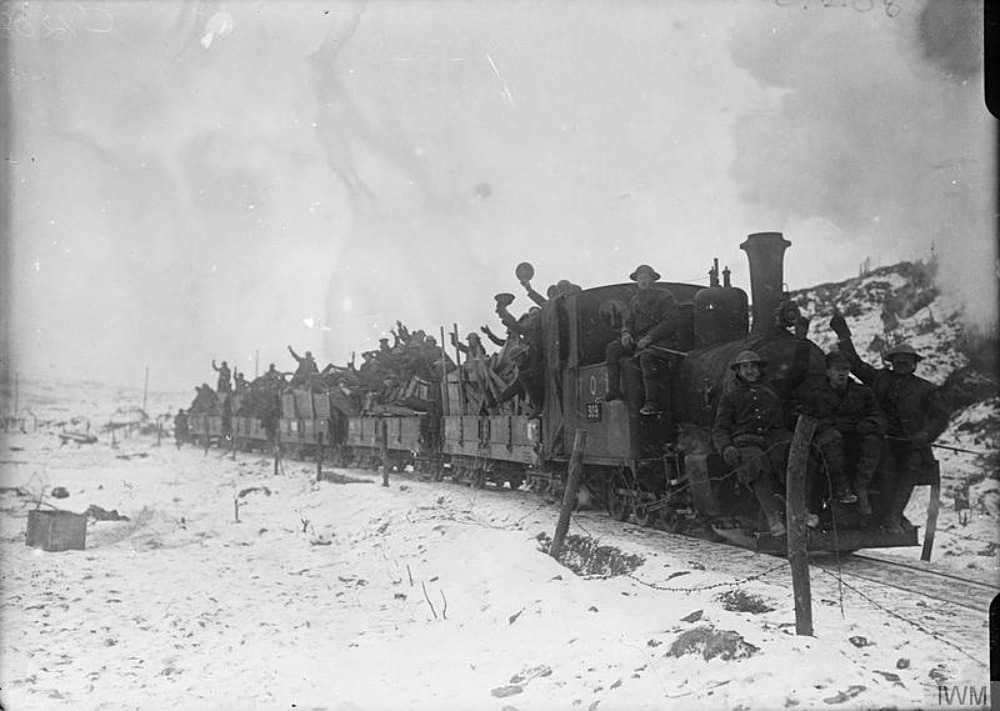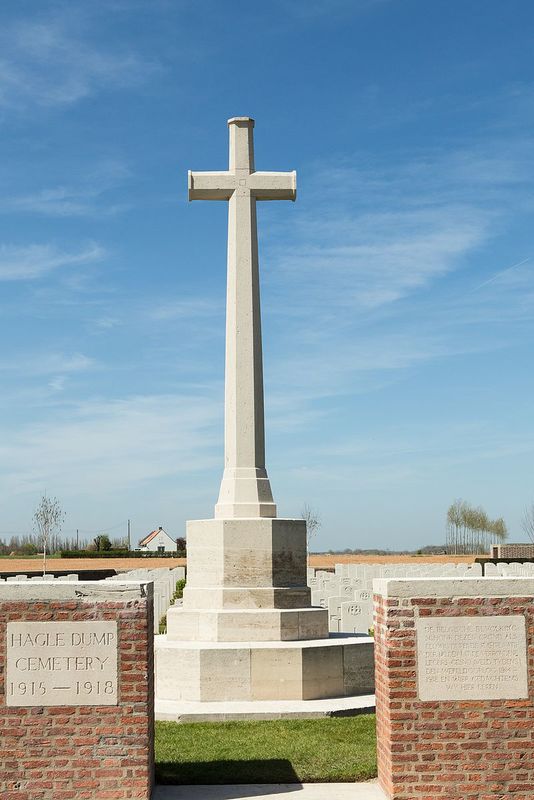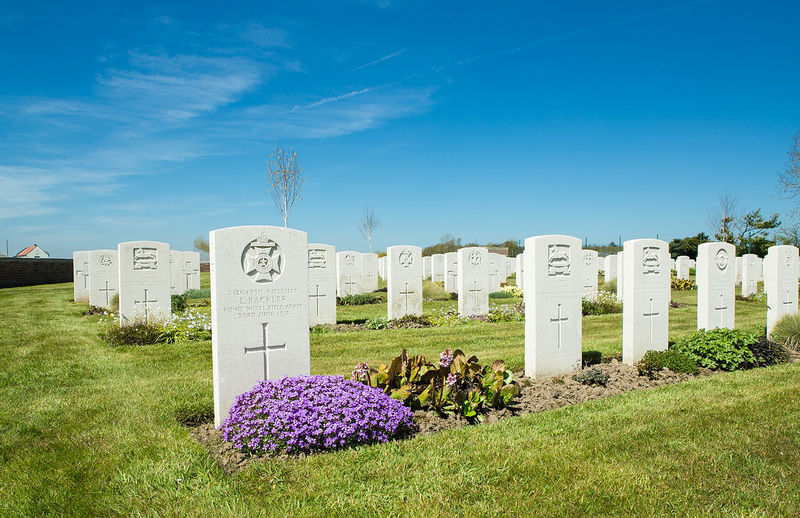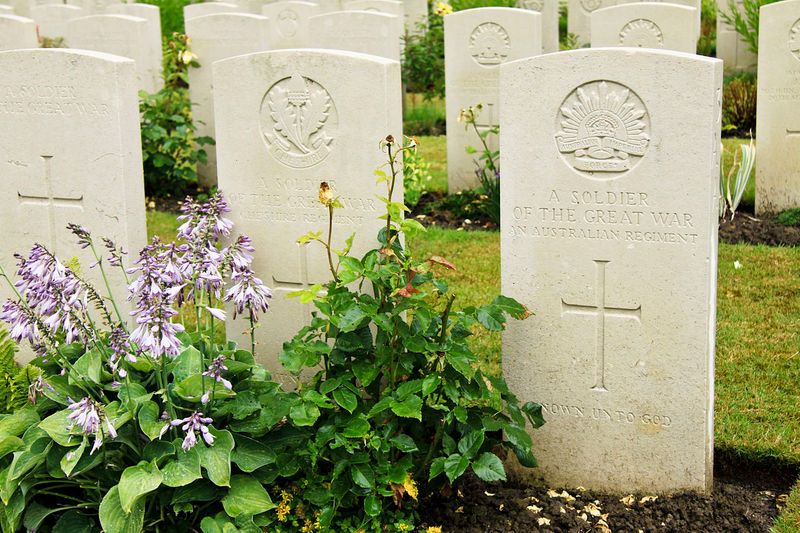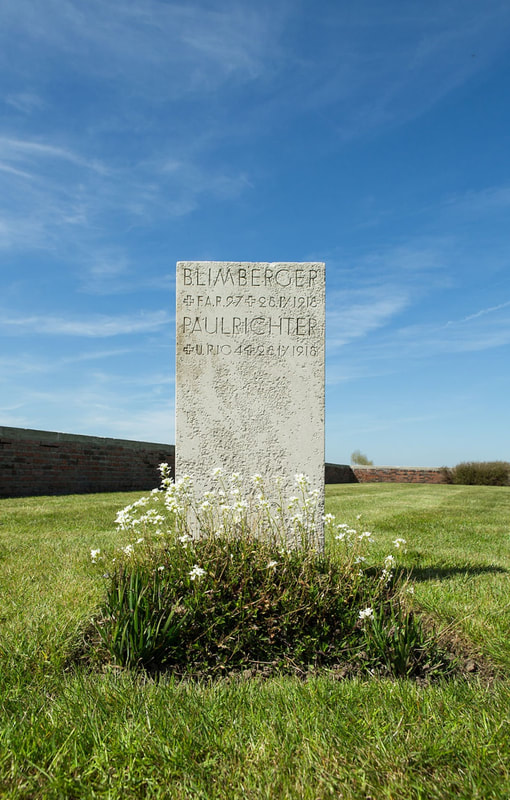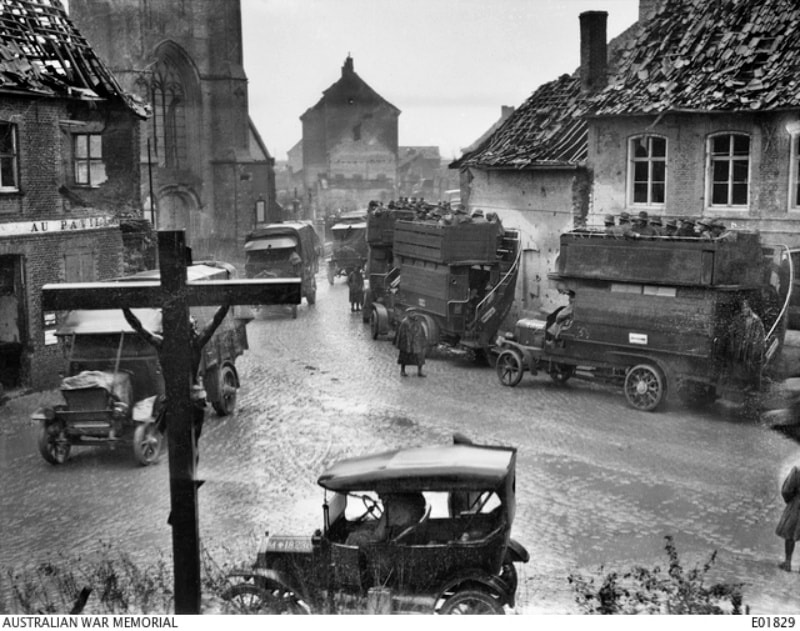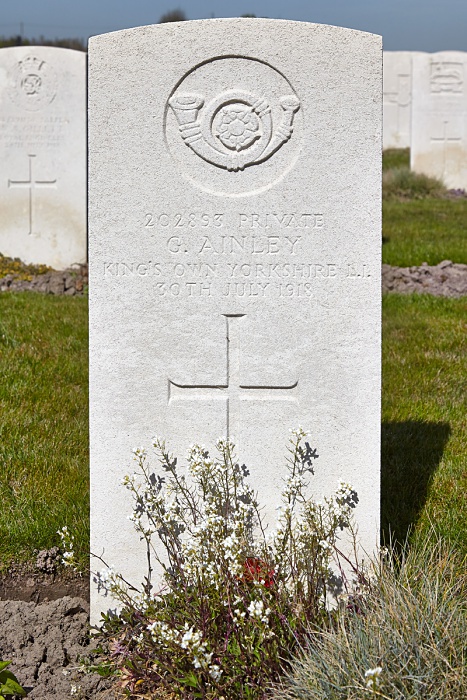HAGLE DUMP CEMETERY
West-Vlaanderen
Belgium
GPS Coordinates: Latitude: 50.86137 Longitude: 2.78191
Location Information
Hagle Dump Cemetery is 7.5 Kms west of Ieper town centre on the Sint Pietersstraat, a road leading from the N308 Poperingseweg, connecting Ieper to Poperinge. From Ieper town centre the Poperingseweg (N308) is reached via Elverdingsestraat then directly over two small roundabouts in the J. Capronstraat. The Poperingseweg is a continuation of the J. Capronstraat and begins after a prominent railway level crossing. 6 Kms along the Poperingseweg, after passing through the villages of Vlamertinge and Brandhoek, lies the right hand turning onto Galgestraat. 1 Km along the Galgestraat lies a staggered crossroads. The cemetery lies 300 metres after this crossroads on Sint Pietersstraat.
Visiting Information
Wheelchair access to the cemetery is possible, but may be by an alternative entrance.
Historical Information
Elverdinge was behind the Allied front line throughout the war, and Hospital Farm and Ferme-Olivier Cemeteries, both in the commune, were used in the earlier years for Commonwealth burials.
The cemetery, which was begun in April 1918, during the Battles of Lys, was named after a nearby stores dump. It was used by fighting units and field ambulances until the following October and was enlarged after the Armistice when more than 200 graves were brought into Plots III and IV from the battlefields of the Ypres Salient and the following cemetery:-
BRIELEN MILITARY CEMETERY, which was close to the South side of Brielen village, contained the graves of 31 French soldiers, 16 from the United Kingdom and four Canadian, and was used from April 1915 to September 1917.
The graves of 26 American soldiers, who fell in July-September 1918, and two French soldiers were removed to other burials grounds.
Hagle Dump Cemetery contains 437 Commonwealth burials of the First World War, 139 of which are unidentified.
The cemetery was designed by Sir Reginald Blomfield and Arthur James Scott Hutton
Total Burials: 439.
Identified Casualties: United Kingdom 280, Australia 11, Canada 7, Germany 2. Total 300.
Unidentified Casualties: 139.
Hagle Dump Cemetery is 7.5 Kms west of Ieper town centre on the Sint Pietersstraat, a road leading from the N308 Poperingseweg, connecting Ieper to Poperinge. From Ieper town centre the Poperingseweg (N308) is reached via Elverdingsestraat then directly over two small roundabouts in the J. Capronstraat. The Poperingseweg is a continuation of the J. Capronstraat and begins after a prominent railway level crossing. 6 Kms along the Poperingseweg, after passing through the villages of Vlamertinge and Brandhoek, lies the right hand turning onto Galgestraat. 1 Km along the Galgestraat lies a staggered crossroads. The cemetery lies 300 metres after this crossroads on Sint Pietersstraat.
Visiting Information
Wheelchair access to the cemetery is possible, but may be by an alternative entrance.
Historical Information
Elverdinge was behind the Allied front line throughout the war, and Hospital Farm and Ferme-Olivier Cemeteries, both in the commune, were used in the earlier years for Commonwealth burials.
The cemetery, which was begun in April 1918, during the Battles of Lys, was named after a nearby stores dump. It was used by fighting units and field ambulances until the following October and was enlarged after the Armistice when more than 200 graves were brought into Plots III and IV from the battlefields of the Ypres Salient and the following cemetery:-
BRIELEN MILITARY CEMETERY, which was close to the South side of Brielen village, contained the graves of 31 French soldiers, 16 from the United Kingdom and four Canadian, and was used from April 1915 to September 1917.
The graves of 26 American soldiers, who fell in July-September 1918, and two French soldiers were removed to other burials grounds.
Hagle Dump Cemetery contains 437 Commonwealth burials of the First World War, 139 of which are unidentified.
The cemetery was designed by Sir Reginald Blomfield and Arthur James Scott Hutton
Total Burials: 439.
Identified Casualties: United Kingdom 280, Australia 11, Canada 7, Germany 2. Total 300.
Unidentified Casualties: 139.
Cemetery images in this gallery © Geerhard Joos
Images in this gallery © Werner Van Caneghem

42082 Sergeant
Gordon Valentine Boone
1st Brigade, Canadian Field Artillery
27th April 1915.
Plot III. D. 6.
Gordon Valentine Boone
1st Brigade, Canadian Field Artillery
27th April 1915.
Plot III. D. 6.
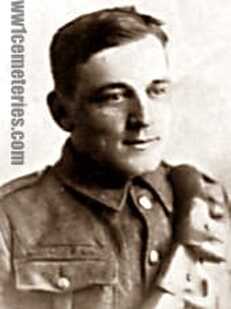
194303 Gunner
William A. Butterfield
188th Siege Battery, Royal Garrison Artillery
18th July 1918.
Plot II. D. 2.
William A. Butterfield
188th Siege Battery, Royal Garrison Artillery
18th July 1918.
Plot II. D. 2.
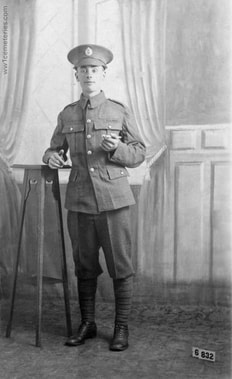
6832 Private
Alexander Wardrope Mathieson
1st Bn. Canadian Infantry
23rd April 1915, aged 23.
Plot III. D. 7.
Son of John and Margaret Mathieson, of Bracebridge, Ontario. Born at Falkirk, Scotland.
His headstone bears the inscription "Gone But Not Forgotten"
Click on image to enlarge
Alexander Wardrope Mathieson
1st Bn. Canadian Infantry
23rd April 1915, aged 23.
Plot III. D. 7.
Son of John and Margaret Mathieson, of Bracebridge, Ontario. Born at Falkirk, Scotland.
His headstone bears the inscription "Gone But Not Forgotten"
Click on image to enlarge

41181 Gunner
John Roderick McIsaac
2nd Brigade, Canadian Field Artillery
27th April 1915, aged 20.
Plot III. D. 5.
Son of Mr. and Mrs. Rod J. McIsaac, of Ben Eoin, Nova Scotia.
John Roderick McIsaac
2nd Brigade, Canadian Field Artillery
27th April 1915, aged 20.
Plot III. D. 5.
Son of Mr. and Mrs. Rod J. McIsaac, of Ben Eoin, Nova Scotia.
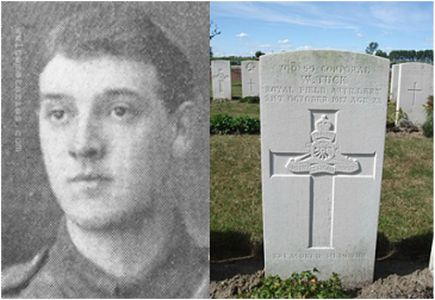
700859 Corporal
Walter Tuck
"C" Bty. 230th Bde. Royal Field Artillery
21st October 1917, aged 22.
Plot IV. C. 5.
Son of Fred and Emma Tuck, of 53, Devonshire Rd., Burnley.
His headstone bears the inscription "Treasured Memories"
Walter Tuck
"C" Bty. 230th Bde. Royal Field Artillery
21st October 1917, aged 22.
Plot IV. C. 5.
Son of Fred and Emma Tuck, of 53, Devonshire Rd., Burnley.
His headstone bears the inscription "Treasured Memories"
Shot at Dawn
202893 Private George Ainley, 1st/4th Bn. Kings Own Yorkshire Light Infantry, executed for desertion on 30th July 1918, aged 20. Plot II. D. 5. Son of George and Alice Mary Ainley, of 82, Randall St., Sheffield, Yorks.
Tried in 1918 for a self-inflicted wound; but offended again, deserting 3 times before the summer. (Putkowski, p 250)
45980 Private Walter Dossett 1st/4th Bn. York and Lancaster Regiment, executed for desertion on 25th June 1918, aged 22. Plot I. E. 7. Son of William and Lily Dossett, of Sheffield.
Absented himself during the Ludendorff Offensive in 1918. He had previously served as a Machine Gunner with 3 different Companies, one of which provided the firing squad. (Putkowski, p 247)
202893 Private George Ainley, 1st/4th Bn. Kings Own Yorkshire Light Infantry, executed for desertion on 30th July 1918, aged 20. Plot II. D. 5. Son of George and Alice Mary Ainley, of 82, Randall St., Sheffield, Yorks.
Tried in 1918 for a self-inflicted wound; but offended again, deserting 3 times before the summer. (Putkowski, p 250)
45980 Private Walter Dossett 1st/4th Bn. York and Lancaster Regiment, executed for desertion on 25th June 1918, aged 22. Plot I. E. 7. Son of William and Lily Dossett, of Sheffield.
Absented himself during the Ludendorff Offensive in 1918. He had previously served as a Machine Gunner with 3 different Companies, one of which provided the firing squad. (Putkowski, p 247)



